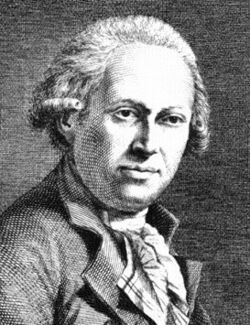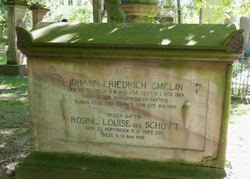Johann Friedrich Gmelin
Topic: Biography
 From HandWiki - Reading time: 4 min
From HandWiki - Reading time: 4 min
J. F. Gmelin | |
|---|---|
 | |
| Born | 8 August 1748 Tübingen, Holy Roman Empire |
| Died | 1 November 1804 (aged 56) Göttingen, Electorate of Brunswick-Lüneburg |
| Citizenship | Germany |
| Alma mater | University of Tübingen |
| Known for | Textbooks on chemistry, pharmaceutical science, mineralogy, and botany |
| Spouse(s) | Rosine Louise Gmelin (1755–1828, née Schott) |
| Scientific career | |
| Fields | Naturalist, botanist, and entomologist |
| Institutions | University of Göttingen University of Tübingen |
| Thesis | Latin: Irritabilitatem vegetabilium, in singulis plantarum partibus exploratam ulterioribusque experimentis confirmatam |
| Doctoral advisor | Philipp Friedrich Gmelin Ferdinand Christoph Oetinger |
| Doctoral students | Georg Friedrich Hildebrandt Friedrich Stromeyer Carl Friedrich Kielmeyer Wilhelm August Lampadius Vasily Severgin |
| Author abbrev. (botany) | J.F.Gmel. |
| Author abbrev. (zoology) | Gmelin |
Johann Friedrich Gmelin (8 August 1748 – 1 November 1804) was a German naturalist, chemist, botanist, entomologist, herpetologist, and malacologist.
Education
Johann Friedrich Gmelin was born as the eldest son of Philipp Friedrich Gmelin in 1748 in Tübingen. He studied medicine under his father[1] at University of Tübingen and graduated with a Master's degree in 1768, with a thesis entitled: Irritabilitatem vegetabilium, in singulis plantarum partibus exploratam ulterioribusque experimentis confirmatam, defended under the presidency of Ferdinand Christoph Oetinger,[2] whom he thanks with the words Patrono et praeceptore in aeternum pie devenerando, pro summis in medicina obtinendis honoribus.
Career
In 1769, Gmelin became an adjunct professor of medicine at University of Tübingen. In 1773, he became professor of philosophy and adjunct professor of medicine at University of Göttingen. He was promoted to full professor of medicine and professor of chemistry, botany, and mineralogy in 1778. He died in 1804 in Göttingen and is buried there in the Albani cemetery with his wife Rosine Louise Gmelin (1755–1828, née Schott).
Johann Friedrich Gmelin when young became an "apostle" of Carl Linnaeus, probably when Linnaeus was working in the Netherlands, and undertook a plant-collecting expedition to "Persia" on his behalf.[3][4] Later in life he published several textbooks in the fields of chemistry, pharmaceutical science, mineralogy, and botany. He also edited and published the posthumous 13th edition of Systema Naturae by Carl Linnaeus from 1788 to 1793. This contained descriptions and scientific names of many new species, including birds that had earlier been catalogued without a scientific name by John Latham in his A General Synopsis of Birds. Gmelin's publication is cited as the authority for over 290 bird species[5] and also a number of butterfly species.[6]
Legacy
Among his students were Georg Friedrich Hildebrandt, Carl Friedrich Kielmeyer, Friedrich Stromeyer, and Wilhelm August Lampadius. He was the father of Leopold Gmelin.
He described the redfin pickerel in 1789. In the scientific field of herpetology, he described many new species of amphibians and reptiles.[7] In the field of malacology, he described and named many species of gastropods.
The plant genus Gmelina was named after Gmelin by Linnaeus.
The abbreviation "Gmel." is also found.[9]
Publications
- Gmelin, Johann Friedrich; Ferdinand Christoph Oetinger (1768). Irritabilitatem vegetabilium, in singulis plantarum partibus exploratam ulterioribusque experimentis confirmatam. Thesis Tübingen. OCLC 10717434.
- Allgemeine Geschichte der Gifte, 2 Vol., 1776/77 Digital edition of the University and State Library Düsseldorf.
- Allgemeine Geschichte der Pflanzengifte, 1777
- Allgemeine Geschichte der mineralischen Gifte. Nürnberg: Raspe, 1777. Digital edition of the University and State Library Düsseldorf.
- Johann Friedrich Gmelins ... Einleitung in die Chemie zum Gebrauch auf Universitäten. Nürnberg: Raspe, 1780. Digital edition of the University and State Library Düsseldorf.
- Einleitung in die Pharmacie. Nürnberg: Raspe, 1781. Digital edition of the University and State Library Düsseldorf.
- Beyträge zur Geschichte des teutschen Bergbaus, 1783
- Über die neuere Entdeckungen in der Lehre von der Luft, und deren Anwendung auf Arzneikunst, in Briefen an einen Arzt, von J. F. Gmelin, 1784
- Grundsätze der technischen Chemie, 1786
- Caroli a Linné, equitis aurati de stella polari, … Systema naturae per regna tria naturae, secundum classes, ordines, genera, species, cum characteribus, differentiis, synonymis, locis. Editio decima tertia, aucta, reformata, Lipsiae [Leipzig], Georg Emanuel Beer, 1788–1793
- Grundriß der Pharmazie, 1792
- Apparatus Medicaminum tam simplicium quam praeparatorum et compositorum in Praxeos Adiumentum consideratus, Ps. 2, T. 1 – Ps. 2, T. 2., 1795–1796. Digital edition of the University and State Library Düsseldorf.
- Geschichte der Chemie, 1799
- Allgemeine Geschichte der thierischen und mineralischen Gifte, 1806
See also
References
- ↑ Mainz, Vera V.; Gregory S. Girolami (1998). "Genealogy Database Entry: Gmelin, Johann Friedrich". School of Chemical Sciences Web Genealogy. University of Illinois, Champaign-Urbana. http://web-genealogy.scs.illinois.edu/Info/gmelinjf.pdf.
- ↑ "'Irritabilitas vegetabilium in singulis plantarum partibus explorata, ulterioribusque experimentis confirmatam publice proponet' - Viewer | MDZ". https://www.digitale-sammlungen.de/en/view/bsb10958646?page=3.
- ↑ Joseph Kastner, A world of naturalists, 1977, Alfred A Knopf, New York; page 35.
- ↑ Wilfrid Blunt, 1971 The Compleat Naturalist. A life of Linnaeus, Collins, London; page 190
- ↑ Gill, Frank; Donsker, David, eds. "IOC World Bird List Version 5.4". International Ornithologists' Union. http://www.worldbirdnames.org/.
- ↑ Vane-Wright, R. I., 1975. The butterflies named by J. F. Gmelin (Lepidoptera: Rhopalocera). Bulletin of the British Museum (Natural History), Entomology, 32: 17–64.pdf
- ↑ The Reptile Database. www.reptile-database.org.
- ↑ IPNI, J.F.Gmel., http://www.ipni.org/ipni/advAuthorSearch.do?find_abbreviation=J.F.Gmel.
- ↑ See for instance: Audubon, John James (1831) – Ornithological Biography : Volume 1, p. 232. Online available at wikisource.
- Vane-Wright, R. I., 1975. The butterflies named by J. F. Gmelin (Lepidoptera: Rhopalocera).Bulletin of the British Museum (Natural History),Entomology, 32: 17–64.pdf
External links
- Gmelin's chemical genealogy
- Johann Friedrich Gmelin at the Mathematics Genealogy Project
- Johann Friedrich Gmelin in the German National Library catalogue
- Global Ant Project — World Ant Taxonomists: Johann Friedrich Gmelin (1748–1804)
- "Author Details for Johann Friedrich Gmelin" (HTML). International Plant Names Index. International Organization for Plant Information (IOPI). http://www.ipni.org/ipni/idAuthorSearch.do?id=3203-1.
- books by Johann Friedrich Gmelin at Internet Archive
- Zoologica Göttingen State and University Library
 |
 KSF
KSF
